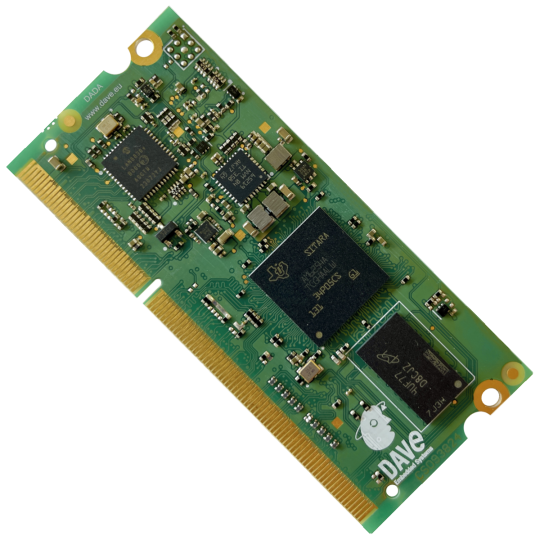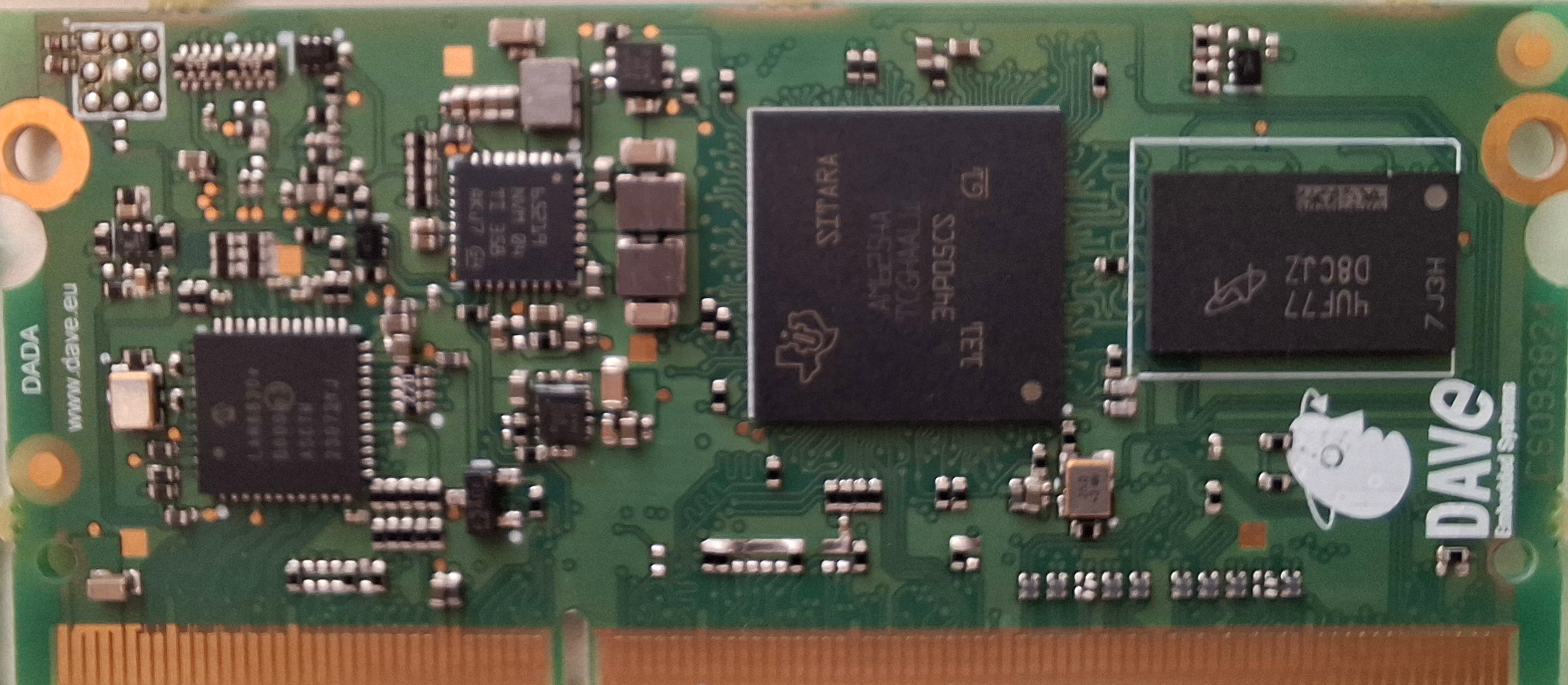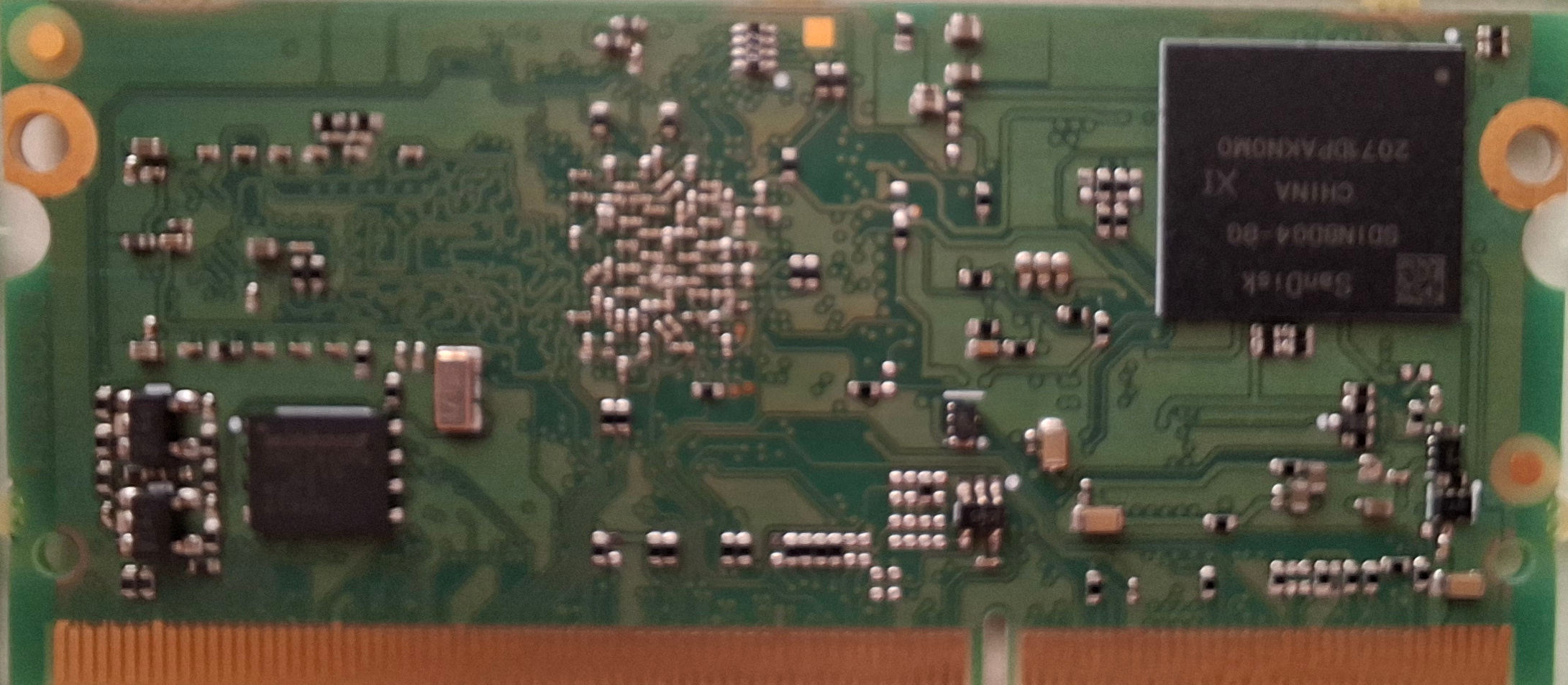
Cart
CloseNo products in the shopping cart.

No products in the shopping cart.



Texas Instruments AM62x - DADA SOM
PREVIEW
The DADA SOM, developed by DAVE Embedded Systems, is a System On Module (SOM) featuring the Texas Instruments AM62x application processor. This SOM is part of DAVE Embedded Systems' Industrial product portfolio, ensuring compatibility and enabling the creation of flexible and scalable solutions. With a minimum availability of 15 years, it meets the demands for reliable and long-lasting industrial applications.
Equipped with a comprehensive suite of peripherals and internal processing units, the DADA SOM includes dual MAC Ethernet, integrated PRUs, and a security management system, making it ideal for industrial and secure connected applications.
DADA SOM is integrated into ToloMEO, DAVE Embedded Systems' solution for Edge Data Orchestration and Industry 5.0. With ToloMEO, DADA SOM is natively connected to the cloud, enabling data collection and remote OTA updates. It also supports the integration of Machine Learning Algorithms running on the internal ARM cores and PRUs. Additionally, it handles edge activities within a Trust Zone Area for managing legally bounded supply chain transactions. Cybersecurity protection is ensured through VCE monitoring and Safety Update applications. Lastly, the Embedded Manager module oversees the software life cycle and BSP design.
DADA SOM is specifically designed for industrial and healthcare applications. With ToloMEO, DADA SOM is the answer for designing a perfect fleet of edge devices compliant within the standard regulations for data security and protection.
Main Features


|

|
CPU |
|
| Memory |
|
| Interfaces (full-spec models) |
|
| Mechanical |
|
Power Supply |
|
| BSP |
|

Yes. DADA SOM is particularly suited for industrial automation, HMI, and edge computing, thanks to its power-efficient architecture and integrated multimedia capabilities.

DADA SOM ensures product longevity, scalability, and support throughout the product lifecycle, reducing time-to-market and maintenance costs.

DADA SOM integrates advanced power management features from the TI AM62x platform, optimising performance and energy efficiency for industrial workloads.

Yes. DADA SOM supports secure boot and hardware-based security features provided by the AM62x architecture, ensuring data integrity and device protection.

DADA SOM supports multiple memory options, including DDR4, eMMC, and QSPI, to match different performance and cost requirements.

DADA SOM is fully compatible with ToloMEO, DAVE Embedded Systems’ solution for Edge Data Orchestration and Industry 5.0.
Through ToloMEO, DADA SOM enables secure cloud connectivity, remote OTA updates, and edge intelligence with integrated Machine Learning and Trust Zone protection. The system ensures cybersecurity, data orchestration, and complete software lifecycle management via the Embedded Manager module.

DAVE Embedded Systems provides tools and documentation to manage secure software updates and ensure long-term software maintenance for DADA SOM.

DADA SOM offers low power consumption thanks to the efficient AM62x design, making it ideal for fanless and energy-sensitive embedded systems.

Technical resources, design guides, and BSP documentation for DADA SOM are available through DAVE Embedded Systems’ wiki.

You can download the official DADA SOM product brochure here.
The leaflet provides an overview of the Texas Instruments AM62x-based DADA SOM, including its key features, performance highlights, and integration options for industrial and embedded applications. It’s an excellent resource to quickly understand how DADA SOM fits into your project.
Please note: to access this document, you must be registered on the DAVE Embedded Systems website.
If you are not yet registered, follow this short video guide to create your account: How to register to the DAVE Embedded Systems website

The Part Number (P/N) of DADA SOM is a structured code that defines the exact configuration and hardware options of the module. Each element of the P/N corresponds to a specific component or feature — such as memory size, processor variant, temperature range, or connector type — ensuring clear identification and traceability of your System on Module.
You can find a detailed explanation of how the DADA SOM Part Number is composed on the official DAVE Embedded Systems Wiki: DADA SOM P/N composition

DADA SOM is part of DAVE Embedded Systems’ Longevity Program, designed to guarantee product availability and support for industrial applications over time. This programme ensures that DADA SOM remains available for long-term production, minimising redesign risks and lifecycle management costs.
You can find detailed information on the DADA SOM Longevity Program on the official DAVE Embedded Systems Wiki: DADA SOM Longevity Program

Through the Longevity Program, DAVE Embedded Systems commits to maintaining availability, technical support, and update services for DADA SOM for a minimum of 10 years from the product release date. This long-term roadmap provides stability for industrial customers who need guaranteed component continuity.
For more details, visit the Wiki page: DADA SOM Longevity Program

To request support from the DAVE Embedded Systems technical team, simply fill out the form available at this link: Online Technical Helpdesk
Once submitted, a support ticket will be generated automatically. Our engineers will review your request and typically respond via email within 24 hours, providing detailed assistance or troubleshooting guidance depending on the issue.
If you need help submitting your request, we’ve prepared a short video tutorial that guides you through the process – watch it here: How to contact DAVE technical support

No worries – if you ever need to return your DADA SOM for service, repair, or inspection, DAVE Embedded Systems has a dedicated RMA (Return Material Authorisation) process ready for you.
Simply visit this page and follow the steps to submit your request: RMA Return Material Authorization Inquiry
Once submitted, you’ll receive a confirmation ticket and further details by email to complete the return smoothly.

All hardware resources for DADA SOM — including schematics, layout files, mechanical drawings, and detailed hardware manuals — are available on the official DAVE Embedded Systems wiki.
You can access the full collection here: DADA Hardware documentation
This section is constantly updated to provide the latest documentation and design references for developers and engineers.

The Processor and Memory Subsystem section of the DAVE Embedded Systems Wiki provides an in-depth overview of how the Texas Instruments AM62x processor is implemented on DADA SOM, together with the associated DDR4 memory architecture, storage options, and power domains.
This documentation helps developers understand the module’s internal structure and optimise system design for performance and stability.
You can explore all details here: DADA SOM - Processor and memory subsystem

The Hardware Versioning and Tracking section on the DAVE Embedded Systems Wiki explains how DADA SOM hardware revisions are managed and identified throughout the product lifecycle. Each hardware release is assigned a specific version code, ensuring full traceability, clear documentation of changes, and compatibility awareness for developers and integrators.
You can find complete details and revision references here: DADA SOM - Hardware versioning and tracking

The Hardware Part Number Composition section on the DAVE Embedded Systems Wiki describes how each DADA SOM part number is structured to identify the exact hardware configuration of the module.
Every element in the part number corresponds to a specific feature — such as processor version, memory size, temperature range, or connector type — allowing accurate product identification and traceability.
You can find the full breakdown here: DADA SOM P/N composition

If you’re interested in evaluating or purchasing DADA SOM, you can easily request a customised quotation through our online form.
Just fill in your project details and technical requirements — our sales and engineering teams will review your request and get back to you promptly with a tailored offer and any additional information you may need.

The Pinout Table for DADA SOM provides a complete description of all module signal connections, including power lines, communication interfaces, GPIOs, and peripheral mappings.
This information is essential for designing carrier boards and ensuring proper hardware integration with your system.
You can find the full and regularly updated table here: DADA SOM - Connectors and Pinout Table

The ODD Pins Declaration section of the DADA SOM Wiki provides a detailed description of all odd-numbered connector pins, including their signal names, voltage levels, and functional roles.
This reference is essential when designing or debugging custom carrier boards to ensure correct electrical and logical connections.
You can access the complete table here: DADA SOM - Pinout Table ODD pins declaration

The EVEN Pins Declaration section of the DADA SOM Wiki provides a detailed description of all even-numbered connector pins, including their electrical characteristics, signal functions, and voltage references.
This documentation is essential for hardware designers integrating DADA SOM into custom carrier boards, ensuring accurate signal routing and compatibility.
You can view the complete table here: DADA SOM - Pinout Table EVEN pins declaration

The Power Supply Unit (PSU) and Recommended Power-Up Sequence section of the DADA SOM Wiki provides detailed guidelines for properly powering the module. It explains the required input voltage levels, power domains, and startup timing needed to ensure system stability and reliable operation.
This documentation is essential for hardware designers defining the carrier board’s power architecture or validating power sequencing in industrial environments.
You can read the full guide here: DADA SOM - Power Supply Unit (PSU) and recommended power-up sequence

The Reset Scheme and Control Signals section of the DADA SOM Wiki provides a detailed overview of the module’s reset architecture, including the main reset sources, control logic, and signal behaviour during power-up and system operation.
It also explains how external components can interact with DADA SOM reset lines to ensure reliable system management and proper recovery in case of faults.
You can explore the full documentation here: DADA SOM - Reset scheme and control signals

The System Boot section of the DADA SOM Wiki describes in detail how the module manages its boot sequence, from power-up to operating system loading.
It explains the boot sources, such as eMMC, QSPI, SD card, or network, and how to configure them through hardware settings and boot pins. The section also outlines the role of the internal bootloader and the logic behind boot priority and fallback modes.
You can explore the full documentation here: DADA SOM - System boot

The JTAG section of the DADA SOM Wiki explains how to access and use the JTAG interface for debugging and low-level development. It describes the connector type, pin mapping, electrical requirements, and supported debug features of the Texas Instruments AM62x processor.
This documentation is particularly useful for engineers performing board bring-up, hardware validation, or firmware debugging.
You can find all details here: DADA SOM - JTAG

DADA SOM offers a wide range of on-board peripherals designed to support industrial and embedded applications.
Each peripheral is documented in detail in the official Wiki, with signal descriptions, electrical characteristics, and integration guidelines.
You can find full technical information for each of the following peripherals:

The Operational Characteristics section of the DADA SOM Wiki provides key electrical specifications, including maximum ratings, recommended operating conditions, and detailed power consumption data.
This information helps developers ensure that DADA SOM operates within safe limits and meets the performance and reliability requirements of their application.
You can access the full details here: DADA SOM - Operational characteristics

The Thermal Management and Heat Dissipation section of the DADA SOM Wiki explains that the module is designed to operate within the maximum temperature range declared by the manufacturer.
It is the customer’s responsibility to perform adequate testing and verification to confirm that the Device Under Test (DUT) can properly handle heat dissipation in their specific application.
The use of heatsinks, fans, or other cooling solutions must be evaluated case by case, according to system design and operating conditions.

The Mechanical Specifications section of the DADA SOM Wiki provides all the information needed to integrate the module into your hardware design.
It includes the mechanical dimensions, connector placement, and a 3D model that helps verify mechanical compatibility and enclosure design.
These resources are essential for ensuring a correct physical fit and reliable assembly in your target system.
You can find the full documentation here: DADA SOM - Mechanical specifications

The complete DADA SOM Hardware Manual is available at the following link: DADA SOM - Hardware Manual
This document provides detailed information about the module’s electrical design, mechanical layout, connectors, and integration guidelines, making it an essential resource for developers and hardware engineers.
Please note: to access this document, you must be registered on the DAVE Embedded Systems website.
If you are not yet registered, follow this short video guide to create your account: How to register to the DAVE Embedded Systems website

The DADA SOM block diagram — which shows the internal architecture and main signal connections of the module — is available both on this product page and on the official DAVE Embedded Systems Wiki.
You can view or download it in high resolution here: DADA SOM - Block Diagram

All software documentation and development resources for DADA SOM are available in the DESK-AM-L section of the DAVE Embedded Systems Wiki.
This area provides everything needed to start developing with the module, including Board Support Package (BSP) details, Linux kernel configuration, Yocto environment setup, and software tools for building, debugging, and customising your system.
You can explore the complete software documentation here: DADA Software Linux Kit: DESK-AM-L documentation

All Application Notes (ANs) for DADA SOM are collected in a dedicated section of the DAVE Embedded Systems Wiki.
These documents provide practical examples, implementation guidelines, and software–hardware integration tips, helping developers accelerate their design and improve system performance.
You can browse the complete list of available documents here: DADA Application Notes

All Technical Notes (TNs) for DADA SOM are available in a dedicated section of the DAVE Embedded Systems Wiki.
These documents provide in-depth technical insights, design recommendations, and detailed analyses of specific hardware or software features, supporting developers during system integration and validation.
You can access the complete collection here: DADA Technical Notes

All White Papers (WPs) for DADA SOM are available in a dedicated section of the DAVE Embedded Systems Wiki.
These documents explore key technological concepts, design methodologies, and system-level approaches related to DADA SOM, offering a deeper understanding of the module’s capabilities and its role in embedded and industrial applications.
You can access the full list of White Papers here: DADA White Papers

All Case Histories (CHs) related to DADA SOM are available in the dedicated section of the DAVE Embedded Systems Wiki.
These documents showcase real-world projects and industrial applications where DADA SOM has been successfully integrated, illustrating practical examples of system design, performance, and reliability in action.
You can explore all case studies here: DADA Case Histories

DADA SOM is based on the Texas Instruments AM62x processor, designed for industrial and embedded applications that demand efficiency, scalability, and long-term availability.

DADA SOM supports Linux distributions optimised for embedded and industrial environments. DAVE Embedded Systems provides ready-to-use BSPs and long-term support options.

DADA SOM includes a wide range of interfaces such as Ethernet, USB, UART, SPI, I²C, and display interfaces, making it ideal for industrial IoT, HMI, and control systems.

DADA SOM is designed and manufactured for high reliability, offering extended temperature ranges, long-term component availability, and hardware/software support guaranteed by DAVE Embedded Systems.

DAVE Embedded Systems provides development kits and carrier boards that allow engineers to quickly start evaluation and prototyping using DADA SOM.

DADA SOM can be customised in terms of memory, interfaces, and form factor. DAVE Embedded Systems offers design services to adapt the SOM to project-specific needs.
Welcome to the DAVE Embedded Systems' technical information form submission portal!
Please fill in the fields below. The support team will take care of you in maximum 24h!
Welcome to the DAVE Embedded Systems' Documentation system. Please fill in with required information and you will get your document! Thank you!.
We use cookies to personalize content, to get traffic statistics and to improve your experience on our website.
Please read our Cookie Policy for a more detailed description and click on the "Manage preferences" button to customize how the site uses cookies for you. By clicking on "Accept all cookies" you give your consent for the use of each type of cookie.
These cookies are necessary for the website to function and cannot be switched off in our systems.
You can set your browser to block or alert you about these cookies, but some parts of the site will not then work. These cookies do not store any personally identifiable information.
These cookies allow us to count visits and traffic sources so we can measure and improve the performance of our site. They help us to know which pages are the most and least popular and see how visitors move around the site.
All information these cookies collect is aggregated and therefore anonymous. If you do not allow these cookies we will not know when you have visited our site, and will not be able to monitor its performance.
Select all Deselect all